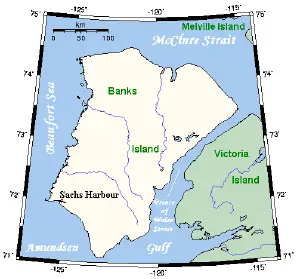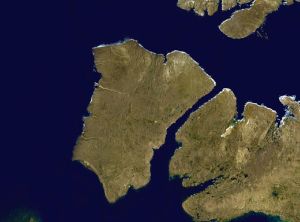Banks Island
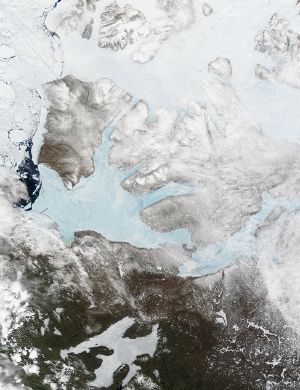 These Moderate resolution Imaging Spectroradiometer Images from June 14 and 16, 2002, show Banks Island (upper left) and Victoria Island (to the southeast) | |
| Geography | |
|---|---|
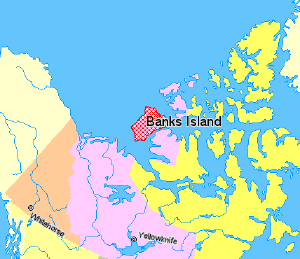 | |
| Location | Beaufort Sea |
| Coordinates | |
| Archipelago | Canadian Arctic Archipelago |
| Area | 70,028 km² (27,038 sq mi) (24th) |
| Length | 380 km (240 mi) |
| Width | 290 km (180 mi) |
| Highest point | Durham Heights (730 m (2,400 ft)) |
| Country | |
| Territory | |
| Demographics | |
| Population | 114 (as of 2001) |
| Density | .0016 people/km2 |
One of the larger members of the Canadian Arctic Archipelago, Banks Island () is situated in the Inuvik Region of the Northwest Territories, Canada. It is separated from Victoria Island to its east by the Prince of Wales Strait and from the mainland by Amundsen Gulf to its south. The Beaufort Sea lies to its west. To the northeast, McClure Strait separates the island from Prince Patrick Island and Melville Island.
It was named "Banks Island" in 1820 by Sir William Parry in honour of Sir Joseph Banks. However, during the exploration of the area by Robert McClure (1850-1854) the island was marked on their maps as "Baring Island"[1].
The only permanent Inuvialuit settlement on the island, Sachs Harbour, or Ikhuak, lies on the southwest coast. Two federal Migratory Bird Sanctuaries were founded on the island in 1961. The island is treeless, with the tallest plant, the arctic willow, growing occasionally to about the height of a person's knee but usually standing no taller than 10 cm.
Geography
The Canadian Arctic Archipelago is an archipelago north of the Canadian mainland in the Arctic. Situated in the northern extremity of North America and covering about 1,424,500 km² (550,003 sq mi), this group of 36,563 islands comprises much of the territory of Northern Canada – most of Nunavut and part of Northwest Territories.
The archipelago extends some 2,400 km (1,491 mi) longitudinally and 1,900 km (1,180.6 mi) from the mainland to Cape Columbia, the northernmost point on Ellesmere Island. The various islands of the archipelago are separated from each other and the continental mainland by a series of waterways collectively known as the Northwestern Passages. There are 94 major islands (greater than 130 km² (50 sq mi)) and 36,469 minor islands. Banks Island is the fourth largest in the archipelago, fifth largest in Canada, and 24th largest island in the world. It is administratively part of the Northwest Territories.
It covers an area of 70,028 square kilometers (27,038 sq mi). It is approximately 380 kilometers (240 mi) long, and at its widest point at the northern end, 290 kilometers (180 mi) across. The highest point of the island is in the south, Durham Heights, rising to about 730 metres (2,400 ft).[1]
Climate
The island is in the Arctic tundra climatic zone, characterized by long, extremely cold winters.
Climate changes have occurred in recent years, such that sea-ice has been breaking up earlier than normal, taking seals farther south in the summer. Warming has brought various changes; salmon appeared for the first time in nearby waters between 1999 and 2001. New species of birds are migrating to the island, including robins and barn swallows, and more flies and mosquitos have been appearing.
The lives of the island's residents has always revolved around the natural environment; fishing, hunting, and travel. Thus they have considerable knowledge of weather conditions, permafrost, and even erosion patterns. In recent years they have begun to fear that their knowledge of weather patterns may fail, as recent climate changes have made the weather harder to predict.
Flora and fauna
Banks Island is home to Barren-ground Caribou, seals, polar bears, and birds such as robins and swallows. The island has the highest concentration of muskoxen on earth, with estimates of 68,000 to 80,000 animals, approximately 20 percent of which reside in the Aulavik National Park in its northwest.[2]
The Aulavik National Park is a fly-in park that protects approximately 12,274 km (7,626.71 mi) of Arctic lowlands at the northern end of the island. The Thomsen River runs through the park, and is the northernmost navigable river (by canoe) in North America. Ptarmigan and ravens are considered the only year-round birds in the park, although 43 different species make seasonal use of the area.
Aulavik is considered a polar desert and often experiences high winds. Precipitation for the park is approximately 300 mm (12 in) per year.[2] In the southern regions of the park a sparsely vegetated upland plateau reaches a height of 450 m (1,500 ft) above sea level.[2] The park has two major bays, Castel Bay and Mercy Bay, and lies south of the McClure Strait.
In addition to having the highest concentration of musk-oxen on earth, it is also home to the endangered Peary Caribou and the more common Barren-ground Caribou.
The park is completely treeless, and Arctic Foxes, brown and Northern Collared Lemmings, Arctic Hares and wolves roam the rugged terrain. Birds of prey in the park include Snowy Owls, rough-legged hawks, Gyrfalcons, and Peregrine Falcons, who feed on the lemmings.
History
http://www.pc.gc.ca/pn-np/nt/aulavik/natcul/natcul2_E.asp
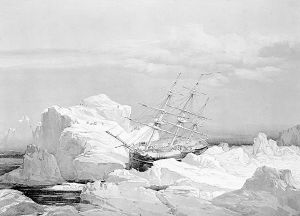
Prior to the arrival of the Thule culture in southern Banks Island there were some Pre-Dorset culture people living in what is now the Aulavik National Park.[3] Due to the cooling climate brought on by the Little Ice Age Banks Island was most likely deserted until the arrival of the Inuvialuit in the 17th century.[3]
Captain Robert McClure spent two winters in Mercy Bay on HMS Investigator, while searching for the missing John Franklin's lost expedition between 1850 and 1853. McClure's team abandoned their ship in Mercy Bay and hiked across the sea-ice of the strait to board another ship, HMS Resolute.
The Mercy Bay area was visited by the Copper Inuit of Victoria Island to salvage materials left by McClure's party. They also hunted the caribou and muskox in the area as evidenced by the large number of food caches. In the 20th century the area was popular with Inuvialuit due to the large numbers of foxes. Until the fur trade went into decline, fox trapping provided a source of income for people from as far away as the Mackenzie Delta and the North Slope of Alaska.[3] This influx of people led to the establishment of Sachs Harbour, the only community on the island.[3]
Population
The only permanent settlement on Banks Island is the hamlet of Sachs Harbour, situated on its southwestern coast. According to Canada's 2006 census, the population was 122 individuals.[4] The town was named after the ship Mary Sachs, which was part of the Canadian Arctic Expedition of 1913.
The community's economy is based largely on hunting and trapping, but tourism also plays a small role. Most of the town lies within 250 yards of the shoreline. Residents also engage in ice fishing, harvesting fish from the Amundsen Gulf and the Beaufort Sea. Oil and gas exploration has provided jobs over the years for some Sachs Harbour residents—estimates of commercially recoverable oil in the Beaufort Sea range from four to 12 billion barrels, and there is believed to be between 13 and 63 trillion cubic feet (1,800 km3) of natural gas.
The two principal languages in the town are Inuvialuktun and English. The traditional name for the area is "Ikahuak", meaning "where you go across to". Bulk supplies of food and other items are brought by barge in the summer months and flights from Inuvik, some 325 miles (523km) to the southwest, operate all year.
The town hosts a goose hunt every spring - Banks Island being the home to the largest goose colony in North America. The community is also home to the largest commercial muskox harvests in Canada. Three quarters of the world's population of muskoxen roam the island. The first Grizzly-polar bear hybrid found in the wild near Sachs Harbour in April 2006.
Notes
- ↑ Historica Foundation of Canada. Banks Island Retrieved February 14, 2009.
- ↑ 2.0 2.1 2.2 Parks Canada.
- ↑ 3.0 3.1 3.2 3.3 History and culture
- ↑ Statistics Canada. All Data, Sachs Harbour Retrieved February 14, 2009.
ReferencesISBN links support NWE through referral fees
- Canada. 1978. Banks Island, a Natural Area of Canadian Significance. Natural area of Canadian significance. Ottawa: Parks Canada. OCLC 31113171
- Cotter, R. C., and J. E. Hines. 2001. "Breeding Biology of Brant on Banks Island, Northwest Territories, Canada". Arctic. 54: 357-366. OCLC 107610126
- Gajewski, K, R Mott, J Ritchie, and K Hadden. 2000. "Holocene Vegetation History of Banks Island, Northwest Territories, Canada". Canadian Journal of Botany. 78: 430-436. OCLC 197133460
- Holyoak, D. T. 1983. Notes on the Birds of Southwestern Banks Island, Northwest Territories, Canada. Bulletin of the British Ornithologists' Club, Vol.103,No.2, June. OCLC 70523333
- Manning, T. H., E. O. Höhn, and A. H. Macpherson. 1956. The Birds of Banks Island. OCLC 4711934
- Parks Canada. Aulavik National Park of Canada Retrieved February 14, 2009.
- Stephens, L. E., L. W. Sobczak, and E. S. Wainwright. 1972. Gravity Measurements on Banks Island, N.W.T. Gravity map series, no. 150. Ottawa: Dept. of Energy, Mines and Resources, Earth Physics Branch. OCLC 85756011
- Struzik, Ed. 2000. "AND THEN THERE WERE 84,000 - The Return of Musk-Oxen to Canada's Banks Island in Recent Decades Is Just One Chapter of a Beguiling Arctic Mystery". International Wildlife. 30, no. 1: 28.
- Toronto Public Library. Frozen Ocean, Search for the Northwest Passage Retrieved February 14, 2009.
- Will, Richard T. 1983. Utilization of Banks Island Muskoxen by Nineteenth Century Copper Inuit. [S.l.]: Boreal Institute for Northern Studies. OCLC 36799378
External links
- US Coast Guard. Historical sites of the Northwest Passage Retrieved February 14, 2009.
Credits
New World Encyclopedia writers and editors rewrote and completed the Wikipedia article in accordance with New World Encyclopedia standards. This article abides by terms of the Creative Commons CC-by-sa 3.0 License (CC-by-sa), which may be used and disseminated with proper attribution. Credit is due under the terms of this license that can reference both the New World Encyclopedia contributors and the selfless volunteer contributors of the Wikimedia Foundation. To cite this article click here for a list of acceptable citing formats.The history of earlier contributions by wikipedians is accessible to researchers here:
- Banks_Island history
- Canadian_Arctic_Archipelago history
- Aulavik_National_Park history
- Sachs_Harbour,_Northwest_Territories history
The history of this article since it was imported to New World Encyclopedia:
Note: Some restrictions may apply to use of individual images which are separately licensed.
